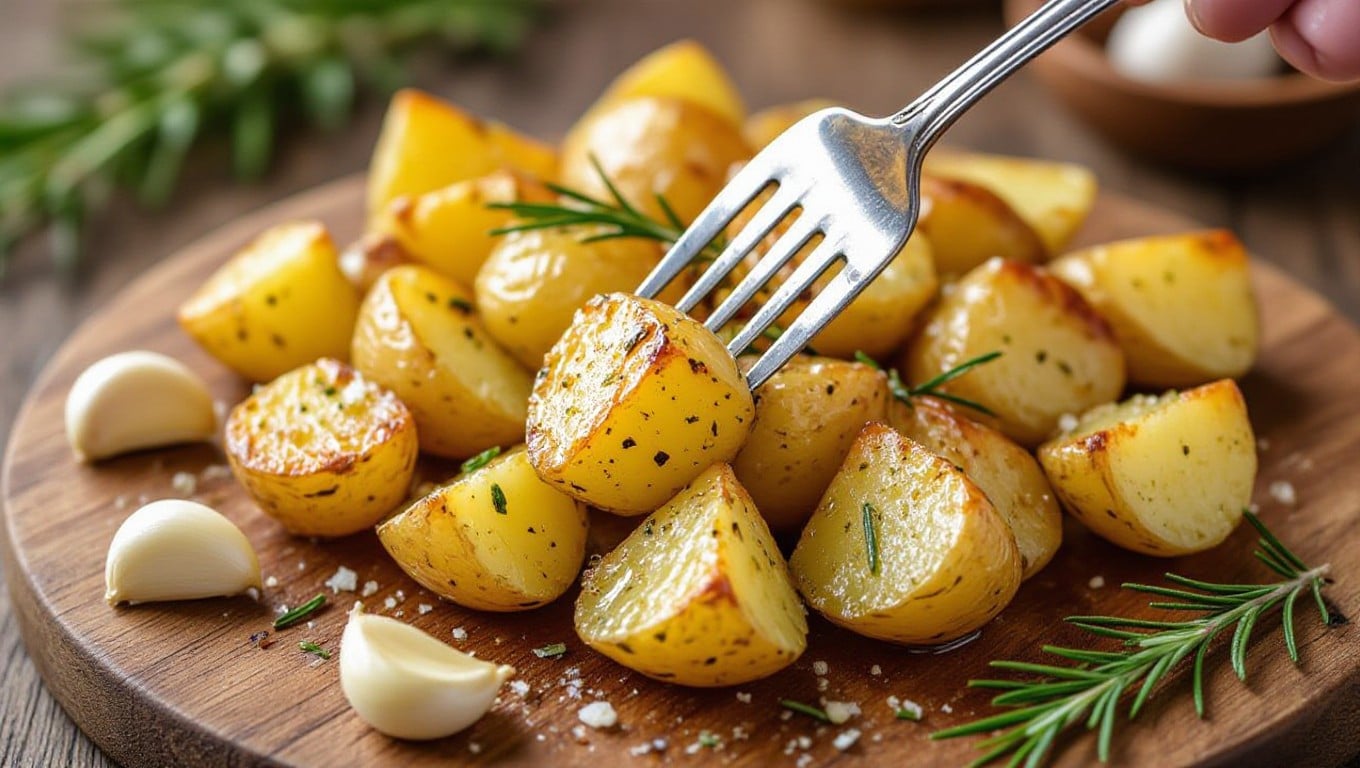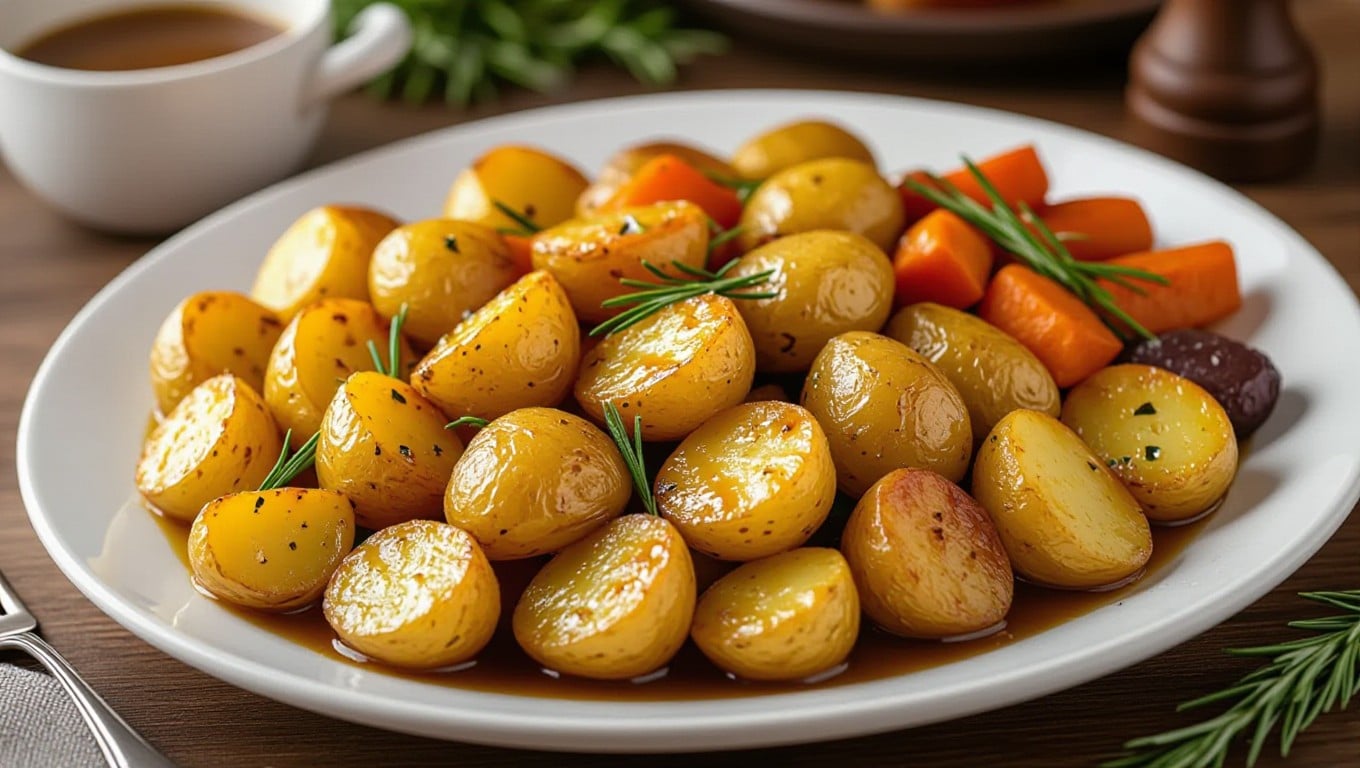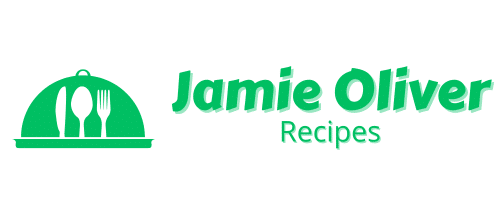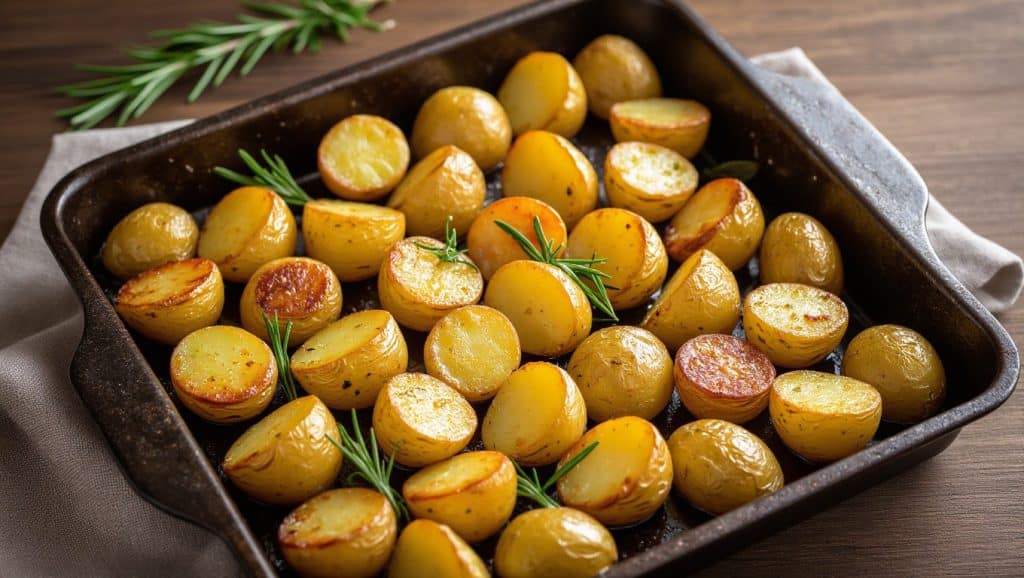The Perfect Roast Potato Unveiled
The Jamie Oliver Crispy Roasted Potatoes with Garlic and Rosemary Recipe is a delightful twist on traditional potato recipes that will elevate your dining experience. Begin by peeling the potatoes and placing them in a large pan of boiling salted water for 15 minutes. This crucial step softens the potatoes while maintaining their firmness, ensuring a fluffy interior. After parboiling, drain in a colander and leave to steam dry for a bit, allowing excess moisture to escape.
For the perfect crispiness, roughen the edges by giving the pot a vigorous shake; this increases the surface area that crisps beautifully during roasting. Next, transfer the potatoes to the largest roasting tray you have, coat them with goose fat or olive oil, and add rosemary leaves and lightly crushed unpeeled cloves of garlic. This combination not only enhances the flavor but also results in potatoes that are golden and crispy on the outside and nice and fluffy on the inside.
Roast in a preheated oven at 200°C, ensuring to roast for a further 20 minutes until they are perfectly crisp and golden. The addition of sea salt and black pepper just before serving will make these rosemary potatoes irresistible. This recipe is a must-try for anyone looking to make the perfect side dish for their Sunday roast or any special occasion, and it aligns beautifully with Jamie’s selection of recipes that highlight the essence of fresh ingredients and bold flavors.
Crispy Garlic & Rosemary Roast Potatoes: Air-fryer Recipes
Prep: 15 min | Cook: 1 hr 20 min | Serves: 6
Ingredients: Maris Piper or russet potatoes, garlic bulbs, fresh rosemary, olive oil, butter or fat, sea salt, black pepper
Method:
- Parboil potatoes for 7–15 min until just tender, drain and shake to roughen edges.
- Toss in hot fat/oil with crushed garlic and rosemary; roast at 180 °C/350 °F.
- After ~1 hr, squash potatoes gently, add more oil and rosemary, roast further 20–30 min until golden and crisp.
- Season and serve immediately.
Secrets of Parboiling: The Steaming Prelude
Parboiling your potatoes softens the inside just enough while keeping their structure intact, laying the groundwork for that irresistible fluffy texture. After peeling and cutting into even chunks, boil them for about 10 minutes until they’re tender but not falling apart. This stage primes the potatoes to absorb the roasting fat later, whether it’s duck fat or olive oil, and allows the surface to roughen when you shake them, creating those signature crispy edges packed with flavor from garlic and rosemary.
The Science Behind Parboiling
The partial boil gelatinizes the exterior starches, which break down during gentle boiling, allowing the outer layers to become fluffy. Meanwhile, the core remains firm, preventing the potato from turning mushy during roasting. When you subsequently shake the potatoes, tiny cracks form on the surface, exposing more starch for caramelization. This combination of starch gelatinization and surface roughening maximizes crispiness once roasted in hot fat, unlocking that harmonious contrast between golden crunch and soft interior.
Timing It Right for Maximum Fluffiness
Parboiling potatoes for exactly 10 minutes results in the perfect texture balance—if boiled too briefly, the potatoes won’t soften enough internally, and if boiled too long, the pieces risk disintegrating during roasting. Testing doneness by piercing with a fork can help: the fork should meet slight resistance without the potato collapsing. Consistency in size also matters, so your chunks cook evenly. Precise timing ensures that when roasted with garlic and rosemary in hot duck fat or olive oil, your potatoes will come out irresistibly fluffy inside and golden outside every time.

Mastering the Shake: Rough Edges for Crispy Perfection
After parboiling, shaking the potatoes in the pot or colander roughens their edges, enhancing crispiness during roasting. This step creates a textured surface that allows the hot oil to cling and crisp evenly, producing that iconic golden crust. You’ll notice the potatoes puff slightly and develop a rough exterior perfect for absorbing the aromatic garlic and rosemary flavors. Skipping this shake means missing out on that signature crunch that transforms simple potatoes into irresistible Jamie Oliver–style roasties.
Techniques to Achieve the Ideal Texture
Gentle but vigorous shaking after draining is key—you want to disrupt the smooth potato surface without breaking them apart. Using a sturdy lid or a sieve helps create friction to flake the outside just enough. Tossing the potatoes with a handful of semolina or flour before roasting adds extra crunch, while keeping them evenly spaced ensures radiant heat circulates for a golden finish. Combining these methods guarantees a fluffy inside with a beautifully crispy exterior.
The Role of Starch in Crispiness
Starch acts as the foundation for that sought-after crunch. Parboiling releases excess starch from the potatoes’ surface, and roughing up the edges exposes more starch granules. When roasted in hot fat, these granules gelatinize and then harden, forming a crispy shell. Varieties like Maris Piper or King Edward, known for their high starch content, deliver the best results by maximizing this crispy effect.
Understanding starch’s function helps refine your approach: if potatoes are underparboiled, excess starch remains trapped, causing a gummy texture; overparboiling washes away too much starch, resulting in a bland crust. The sweet spot lets the starch swell and then dry out, ensuring each bite crackles on the outside while maintaining a tender inside. This balance is why high-starch potatoes paired with the shake technique and roasting in fat produce those perfect Jamie Oliver crispy roast potatoes with garlic and rosemary.
[VIDEO] Perfect Roast Potatoes by Jamie Oliver
The Magic of Hot Oil: Choosing Your Fat
Roasting your potatoes in smoking-hot fat creates that signature crisp golden crust Jamie Oliver champions. The intense heat instantly caramelizes the outer layer while sealing moisture inside for a fluffy center. Whether you opt for duck fat or olive oil, heating it to around 190°C (375°F) ensures the potatoes don’t absorb grease but crisp beautifully. This step transforms rustic spuds into indulgent, irresistibly textured bites that elevate any roast dinner or casual meal alike.
Duck Fat vs. Olive Oil: A Flavor Showdown
Duck fat brings a rich, savory depth and unparalleled crispiness, beloved in traditional British roasting. Its high smoke point and natural flavor make potatoes decadently golden. Olive oil offers a lighter, fruitier profile with healthful fats and subtle earthiness, ideal if you prefer a less intense taste or a vegan-friendly option. Both fats achieve crisp textures, but duck fat’s luxurious mouthfeel stands out for extra-special occasions.
Infusing Flavor with Garlic and Rosemary
Tossing your potatoes in garlic cloves and fresh rosemary before roasting infuses them with warming, aromatic notes that permeate each crispy chunk. As the oil bubbles, the herbs release important oils, while garlic softens and caramelizes, layering bold, fragrant flavors that complement the potatoes’ richness perfectly.
To extract maximum essence, slightly crush whole garlic cloves and tear rosemary sprigs just before roasting—this breaks down cell walls, unleashing more potent flavors. You’ll notice the oven’s heat transforms garlic into mellow, sweet nuggets and rosemary into crisp, flavor-packed shards that stick to the potatoes’ rough edges after shaking. This combination harmonizes beautifully with the fat’s savory tones, turning simple roasties into a memorable centerpiece for any meal.
Serving Spectacularly: Pairing Your Roast Potatoes
The irresistibly crisp texture and aromatic notes of garlic and rosemary means your roast potatoes deserve thoughtfully chosen accompaniments. Rich meats and vibrant vegetables create balanced plates where the potatoes’ golden crunch shines. Duck fat’s savory depth complements robust proteins, while olive oil keeps things lighter, perfect for pairing with herb-forward or citrusy dishes. Texture and flavor contrast elevate the meal — think silky gravy, tangy chutneys, or fresh green sides offering brightness. Your choice of pairings transforms these potatoes from simple side to star of the table, ideal across dinners and celebrations alike.
Best Protein Matches for a Sunday Roast
Roast beef, lamb, and pork work beautifully alongside your crispy potatoes, with each protein lending unique flavor notes. Beef’s hearty richness pairs well with the potatoes’ herb-infused roastiness, while lamb’s gaminess is enhanced by rosemary’s piney tones. Pork’s slightly sweet, savory profile balances the garlic’s pungency. Opt for traditionally basted cuts or herb-crusted roasts to echo the potatoes’ flavors, then finish with a robust red wine gravy or mint sauce. This harmony of tastes and textures delivers a classic, satisfying Sunday spread.
Elevating Holiday Meals with the Perfect Side
Golden roast potatoes offer a festive touch to holiday spreads, pairing exceptionally well with turkey and glazed ham. Their crispy exteriors and fluffy centers contrast the tender, juicy main courses, while the garlic and rosemary infuse warmth fitting for seasonal flavors. Adding sides like roasted root vegetables, cranberry relish, or rich stuffing complements the potatoes’ savory profile and rounds out the festive feast.

The Art of Reheating: Keeping the Crunch Alive
Reviving your Jamie Oliver crispy roast potatoes without losing their signature crunch requires a careful approach. Avoid microwaves, which can make them soggy; instead, reheat in a preheated oven at 200°C (390°F) for about 10-15 minutes on a baking tray. Adding a sprinkle of extra rosemary or a light drizzle of olive oil helps refresh their golden edges. For crispier results, flipping the potatoes halfway through reheating ensures even texture, bringing back that irresistible crispy shell while preserving the fluffy interior.
Best Practices for Leftover Potatoes
Store leftover potatoes in an airtight container and cool them completely before refrigerating to prevent sogginess. Use them within 2-3 days for optimal flavor and texture. When ready to enjoy, let the potatoes come to room temperature briefly, then follow the oven reheating method to restore their crispiness and enhance the garlic-rosemary aromas. Avoid stacking them too densely on the tray to maintain airflow and avoid steaming.
Creative Recipes to Revive Unused Portions
Leftover crispy roast potatoes offer a fantastic base for reinvented dishes. Toss them into a salad with fresh greens, feta, and a lemon dressing, or chop and pan-fry with onions and peppers for a hearty breakfast hash. They also work beautifully in soups—blended for creamy texture or as chunky croutons. Experiment with adding them to shakshuka or coating in parmesan and herbs for a crunchy snack.
Expanding on these ideas, chopped leftover roast potatoes transform your meals with minimal effort. Incorporating them into classic dishes like Spanish tortilla adds a comforting twist with their crispy edges and soft centers. They absorb sauces well, so mixing them into stews or curries provides extra substance while maintaining texture contrasts. Their versatility means you reduce waste and keep enjoying that signature Jamie Oliver crispy roast potato flavor beyond the roast itself.
Conclusion: Jamie Oliver Recipes
Drawing together the steps for Jamie Oliver crispy roasted potatoes with garlic and rosemary, you’ll see how parboiling, shaking to create rough edges, and roasting in hot oil combine to create perfect texture and flavor. Choosing between duck fat or olive oil allows you to customize richness and taste. These potatoes are ideal alongside your Sunday roast, holiday meals, or steak dinners. When reheating, use the oven to retain crispiness. With these techniques, your roast potatoes will consistently impress, delivering a golden, fluffy, and fragrant side dish every time you prepare them.
Frequently Asked Questions
Which potatoes work best for roast potatoes?
Maris Piper or King Edward potatoes are ideal in the UK; in the US, Russet or Yukon Gold are great substitutes for a fluffy centre and crisp exterior.
Why should I shake the potatoes in a colander?
Giving the parboiled potatoes a gentle shake roughens the edges—creating more surface area for crispiness during roasting.
Can I prepare these roast potatoes ahead of time?
Yes—parboil and shake them, then chill in the fridge overnight before roasting to save time on the day.
How do I get golden, risen Yorkshire-style roasties?
Ensure the fat is screaming hot before adding potatoes. Don’t open the oven door mid‑roast and finish with fresh rosemary tossed in.
Can I air-fry instead of using an oven?
Yes—preheat the air-fryer to 180 °C, roast for 30 min, squash, add rosemary and garlic, then roast another 15 min until crispy.

